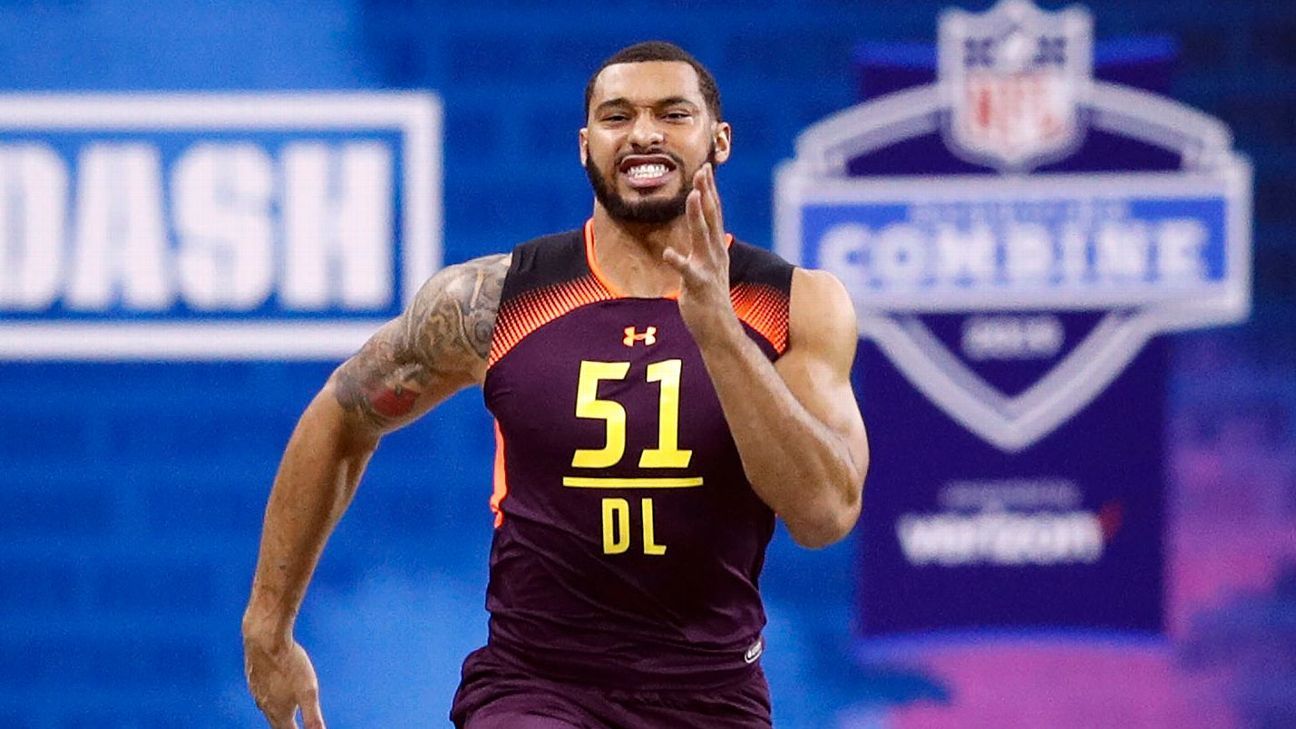Montez Sweat set a record at the NFL scouting combine for the fastest 40-yard dash by a defensive lineman: 4.41 seconds. At 6-foot-6 and 260 pounds. The scouting world took notice.
ESPN draft analyst Mel Kiper had the former Mississippi State defensive end at No. 25 in his mock draft 1.0 in late January. Sweat has risen to No. 8 in Kiper’s latest mock.
After a 12-sack season in 2018 in which he also had 14.5 tackles for loss, Sweat had already established himself as an edge defender prospect. But Sweat’s natural competitiveness pushed him to reach for more as he prepared for April’s NFL draft.
“I am not scared to compete,” Sweat said. “It’s in my nature since I grew up. If you beat me in a game, I always had to run it back. Any opportunity to go out there and compete, I am going to take it because I want to showcase my talent.”
Beyond that, Sweat is driven by the grandparents who raised him. He feels he owes it to them to “make something of himself.”
“My grandparents are like my mom and dad. It’s pretty much all I knew growing up,” Sweat said. “They didn’t have to raise me. They had already raised their children. For them to take me and my brother and sister in, that meant a lot. They are definitely my motivation.”
Devising the plan
Sweat’s goal was to prove himself at the Senior Bowl and add both weight and speed before the combine. He chose to do his draft prep at EXOS in Frisco, Texas, after learning how the team — led by trainer Brent Callaway — helped Saints 2018 first-round pick Marcus Davenport add weight but still finish with a 4.58-second time in the 40-yard dash. Callaway was also endorsed by Bradley Chubb, the No. 5 overall pick in the 2018 draft.
“We have good specialists all over the place,” Callaway said of the team at EXOS. “We sit down collectively as a group and talk strategically about every single athlete. We run down a whole checklist like when you take your car into the shop, and the mechanics are discussing the car.”
The group included a nutritionist, a dietitian, a sleep study technician and a strength/speed coach. They devised a specific development plan for Sweat. The nutritionist decided to ramp up Sweat’s grain intake, and they increased his proteins. Sweat ate a lot of greens and fibers during the day but got to have a cheat meal at night. (Sweat’s cheat choice? Chipotle.)
At the Senior Bowl, Sweat looked like a man among boys in practices, using his powerful hands to knock offensive linemen to the ground. While his performance wasn’t a surprise, his weight gain was.
When Sweat first checked in at EXOS in mid-January, he was 247 pounds. He weighed in at 252 pounds at the Senior Bowl. And when he came back from the Senior Bowl, he weighed 259 pounds. Sweat had put on 12 pounds in 13 days.
When Callaway asked how Sweat gained 7 pounds at the Senior Bowl, Sweat said he was eating everything in Mobile, Alabama, because it was so delicious.
“We sent him in to get his body fat taken, and he was 5.9 percent body fat. At that point, I knew we had a freak. I have not seen a 260-pound, 5.9 percent-body-fat guy gain that much weight in 13 days and look the way he did. He’s a very genetically gifted human being with the work ethic behind that.”
The need for speed
Packing on the pounds was half the battle — getting faster was equally important. Sweat’s first 40 time at EXOS was in the high 4.6s. Callaway harped on getting an explosive start and running with proper form.
“It was mainly the starts,” Sweat said. “[Callaway] told me the start could either make or break your 40. Sometimes I came out of my stance and stood straight up.”
A couple of weeks after the Senior Bowl, Callaway used a computer to analyze Sweat’s sprinting technique. They compared his running to film of elite sprinters. Callaway asked Sweat if he noticed any differences. Sweat pointed out discrepancies in body position and how their feet hit the ground. The next day Sweat was executing what he saw and his times started to drop.
On top of fine-tuning his technique, EXOS wanted Sweat in a group where he could compete. Sweat thrived when competing daily at Mississippi State with fellow defensive end standout Jeffery Simmons, who is a possible Day 1 draft prospect even after tearing an ACL in February. (McShay had Simmons going at No. 21 overall in his latest mock.)
“When you see a guy that’s on your level of talent, you get excited, and that competitor comes out of you. We were always racing to the ball for that big hit or sack or that tackle for a loss. It made us be better players because we were always just competing to a higher standard,” Sweat said of Simmons.
Former LSU linebacker Devin White was in Sweat’s workout group and the competition brought out the best in both.
“They were going at each other from a timing perspective regularly, and next thing you know, nine days from the combine, we were at a 4.46,” Callaway said.
Sweat’s 4.41 time at the combine was even faster than Callaway expected.
Honing his pass-rushing skills
It’s not just about the measurables — Sweat wants to refine his pass-rushing skills, too. Former LSU standout DE Arden Key (now with the Raiders) referred Sweat to pass-rushing coach Chuck Smith of in Atlanta. Sweat has been meeting with Smith since the summer of 2017. Sweat is from the Atlanta area, so he works with Smith two or three times a week when he’s in town.
1:12
Potential top-five pick Montez Sweat combines coveted pass-rushing skills with blazing speed at defensive end, reminiscent of Jadeveon Clowney of the Houston Texans.
Smith has been working to improve his hand placement and movement. Like Callaway, Smith loves Sweat’s work ethic. He also thinks Sweat asks good questions and takes coaching well. His voice lit up when he described some of the things they are working on — including a new addition to Sweat’s pass-rushing repertoire.
“We worked on something called the ‘long-arm ghost.’ It’s a move that Von Miller kind of invented. You use the long arm, then go to the ghost. First you long-arm the guy, then you fake like you’re going to long arm him and bend underneath. We added that so he’s coming into the league with an arsenal. He’s going to be one not to mess with in his rookie year.”
The long-arm move is natural for Sweat thanks to his 35-plus-inch arms. A defensive lineman’s length can be a plus on the field, but offensive lineman can also use it against them.
“Staying low is very important,” Sweat said. “The biggest thing you can give an O-linemen is your chest and upper body. It’s easy for a tall guy to come out of his stance and be tall because that’s what he’s comfortable doing. You have to keep repping, staying low out of your stance.”
After a nine-year career as a defensive end with the Falcons and Panthers, Smith knows what it takes to be a successful pass-rusher and believes Sweat has it.
“Tez is going to outrun guys, and he’s only getting better. He’s still learning. Tez uses his moves, and he’s the prototype — tall and shredded. I think Tez is going to be a great NFL player.”

